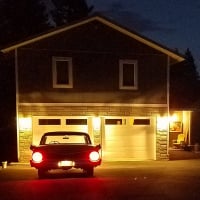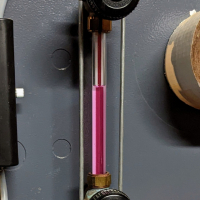Welcome! Here are the website rules, as well as some tips for using this forum.
Need to contact us? Visit https://heatinghelp.com/contact-us/.
Click here to Find a Contractor in your area.
Electicians! Question about fuse substitution
Options

Jamie Hall
Member Posts: 23,324
I am afflcted with a 70 amp rated Royal Electric Company type XJ-48 fuse. Not to exceed 250 VAC rating. It's old (like about 70 years old). It blew for no known reason (wiring checks out with a megger).
Is there any good reason I can't substitute a Littlefuse Time Delay 70 Amp 250 VAC FLNR series for it? Dimensionally the same.
Is there any good reason I can't substitute a Littlefuse Time Delay 70 Amp 250 VAC FLNR series for it? Dimensionally the same.
Br. Jamie, osb
Building superintendent/caretaker, 7200 sq. ft. historic house museum with dependencies in New England
Building superintendent/caretaker, 7200 sq. ft. historic house museum with dependencies in New England
0
Comments
-
I can see no problem, maybe even prevent a nuisance opening if there is any motor load involved.
Is your old fuse the changeable link type?
Years ago you could buy just the links and the ends of the cartridge would unscrew for changing.
Not in use any more as there was some replaced with just copper wire for the link, never a blown fuse then.0 -
Just the occasional fire!JUGHNE said:I can see no problem, maybe even prevent a nuisance opening if there is any motor load involved.
Is your old fuse the changeable link type?
Years ago you could buy just the links and the ends of the cartridge would unscrew for changing.
Not in use any more as there was some replaced with just copper wire for the link, never a blown fuse then. 0
0 -
What is the connected load Jamie? And what is the conductor insulation and type (ie NM cable, BX, open conductor, etc)?Serving Northern Maine HVAC & Controls. I burn wood, it smells good!0
-
It's a main fuse -- actually two of them (240 volt single phase) -- protecting an underground line to one of the outbuildings. The whole thing was put in in 1955 after hurricane Diane took out the overhead lines, and honestly I'm not sure what the insulation is -- direct burial anyway, three separate conductors. There is a 60 amp two pole main circuit breaker at the other end -- on the building distribution panel. Maximum connected load is around 50 amps/240 volts, mostly heating units but some lighting and "convenience" sockets. There used to be a 3 hp motor in there, but that went some years back.
I may say, somewhat parenthetically, that this place is an electrician's nightmare... all done to code -- but to the codes in force when various work was done. Interesting...Br. Jamie, osb
Building superintendent/caretaker, 7200 sq. ft. historic house museum with dependencies in New England0 -
Your always safer with time delay fuses. What is your wire size? Is this a motor load?
On NON MOTOR circuits fuses (in general) are sized for the wire so for a 70 am circuit #4 wire is normal
On a motor circuit only the old "one time" fuses were sized at up to 300% (3x) the motor running load. Time delay fuses are usually sized at up to 175% (1.75x) the motor load.
Motor circuit fuses have to handle the starting current which is why motor circuits are allowed to be "overfused" but only when the motor has overload protection either inside the motor, a motor starter or a vfd0 -
The old 70 amp fuse may have been "punched" by the 3 HP motor that is no longer there. Hit with hard starts enough to weaken the link putting it close to opening.
Feeder wire should be #4 copper or #2 aluminum.0 -
60 amp breaker is limited to about 48 amps of load. Most breakers will tip if run at over 80% of rating for any length of time.
The "three" separate conductors is bothering me a little. 2 hots and a neutral? What are they using for the equipment ground?
Maybe they are using the neutral for an equipment ground as well which would be illegal nowadays. Don't know if that was legal in the old days. You only see that on older stoves and electric dryers0 -
The way that he would determine whether or not it's really all right would be to use a Cooper bussmann cross reference that would tell him if those fuses are permissible. I would have to think that they are, since most of the fuses we use in hvacr are indeed time-delay fuses...so he could double check with Cooper bussmann but I wouldn't have any compunction about using that fuse, as long as it's dimensionally the same and has the same over current capacity.0
-
IIRC, an install this old would have allowed a 3 wire service to an outbuilding. The neutral would have been bonded to the sub feed panel with a ground rod or electrode available at that outbuilding. Then a 4 wire system after the sub feed panel.
Just like the main service disconnect for the premises.
If I read my trivia history correctly, the 3 wire circuit for dryers, ranges, wall ovens and cooktops started during WW2 to save copper for the war effort.
There were attempts to change this thru several code cycles but only happened about 12-15 years ago.0 -
I've ordered the Littlefuse.
The main cables are #4 copper, so that should be good. And yes, it is the older style farm wiring -- the neutral is bonded at the outbuilding sub panel, and there are grounding rods (how good they are I haven't a clue...) from that panel.
Thanks all!Br. Jamie, osb
Building superintendent/caretaker, 7200 sq. ft. historic house museum with dependencies in New England2 -
@Jamie Hall in conduit or direct buried????0
-
If you look at datasheets on fuses you'll find how long it takes to blow at a specific current. For example 5A will take X amount of minutes, or hours etc.
Point being they are sized to last a very long time but can still blow eventually even if nothing is wrong.Single pipe quasi-vapor system. Typical operating pressure 0.14 - 0.43 oz. EcoSteam ES-20 Advanced Control for Residential Steam boilers. Rectorseal Steamaster water treatment0 -
Direct buried.EBEBRATT-Ed said:@Jamie Hall in conduit or direct buried????
Br. Jamie, osb
Building superintendent/caretaker, 7200 sq. ft. historic house museum with dependencies in New England0
Categories
- All Categories
- 85.7K THE MAIN WALL
- 3K A-C, Heat Pumps & Refrigeration
- 49 Biomass
- 418 Carbon Monoxide Awareness
- 71 Chimneys & Flues
- 1.9K Domestic Hot Water
- 5.2K Gas Heating
- 92 Geothermal
- 149 Indoor-Air Quality
- 3.2K Oil Heating
- 59 Pipe Deterioration
- 847 Plumbing
- 5.8K Radiant Heating
- 371 Solar
- 14.5K Strictly Steam
- 3.2K Thermostats and Controls
- 50 Water Quality
- 38 Industry Classes
- 47 Job Opportunities
- 15 Recall Announcements


